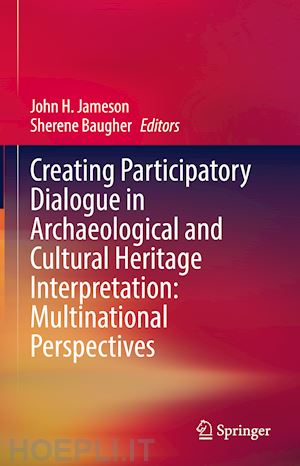
Questo prodotto usufruisce delle SPEDIZIONI GRATIS
selezionando l'opzione Corriere Veloce in fase di ordine.
Pagabile anche con Carta della cultura giovani e del merito, 18App Bonus Cultura e Carta del Docente
This volume examines evolving trends and transnational perspectives on public interpretation of archaeological and cultural heritage, as well as levels of communication, from local to regional, national and international. It is presented in the context of the evolution of cultural heritage studies from the 20th century “expert approach” to the 21st century “people-centered approach,” with public participation and community involvement at all phases of the decision-making process. Our premise is not just about bringing in community members to be partners in decision making processes; some projects are being initiated by the community--not the heritage experts. In some instances, community members are central in initiating and bringing about change rather than the archaeologists or heritage specialists. In several cases in the book, descendants take the lead in changing heritage narratives.
The book addresses several central questions: Do these actions represent new emphases, or more fundamental pedagogical shifts, in interpretation? Are they resulting in more effective interpretation in facilitating emotional and intellectual connections and meanings for audiences? Are they revealing silenced histories? Can they contribute to, or help mediate, dialogues among a diversity of cultures? Can they be shared experiences as examples of good practice at national and international levels? What are the interpretation and presentation challenges for the future?
Cultural heritage, as an expression of a diversity of cultures, can be an important mediator between pasts and futures. In the past, people in power from the dominant ethnic, racial, socio-economic, gender, and religious groups determined the heritage message. Minorities were often silenced; their participation in the building and growth of a city, county, or nation’s history was overlooked. New philosophical/methodological trends in public interpretation are reshaping the messages delivered at archaeological/cultural heritage sites worldwide. The role of the experts, as well as the participatory engagement of audiences and stakeholders are being redefined and reassessed. This book explores these processes, their results and effects on the future.











Il sito utilizza cookie ed altri strumenti di tracciamento che raccolgono informazioni dal dispositivo dell’utente. Oltre ai cookie tecnici ed analitici aggregati, strettamente necessari per il funzionamento di questo sito web, previo consenso dell’utente possono essere installati cookie di profilazione e marketing e cookie dei social media. Cliccando su “Accetto tutti i cookie” saranno attivate tutte le categorie di cookie. Per accettare solo deterninate categorie di cookie, cliccare invece su “Impostazioni cookie”. Chiudendo il banner o continuando a navigare saranno installati solo cookie tecnici. Per maggiori dettagli, consultare la Cookie Policy.